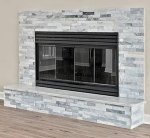- Joined
- Jul 31, 2021
- Messages
- 1,068
- City
- NW Florida
- Vehicle Year
- 1994
- Engine
- 2.3 (4 Cylinder)
- Transmission
- Manual
- Total Drop
- 1.5” till I get these springs replaced
- Tire Size
- 225-70-R14
For about the past decade, their heat pump didn't work and they relied on a combination of the "emergency" heater (electric heat coil in the evap unit) and the fireplace. Being in Florida, that combination was plenty enough to keep the house comfortably in the 60s. I'll have to ask when the last time they had the chimney cleaned. I do remember they had it swept when they bought the house. The fella said it was a missive chimney. He used his largest brush and did half the chimney at a time.
Would it be good to run a chimney pipe inside the chimney? I've seen insulated 10ish inch tubing used to make chimneys. That way there's zero contact between smoke and brick.
Edit: Oh never mind. Looks like that's what you're talking about with a chimney lining. I was picturing some kind of membrane glued to the walls of the chimney.
Would it be good to run a chimney pipe inside the chimney? I've seen insulated 10ish inch tubing used to make chimneys. That way there's zero contact between smoke and brick.
Edit: Oh never mind. Looks like that's what you're talking about with a chimney lining. I was picturing some kind of membrane glued to the walls of the chimney.
Last edited:













